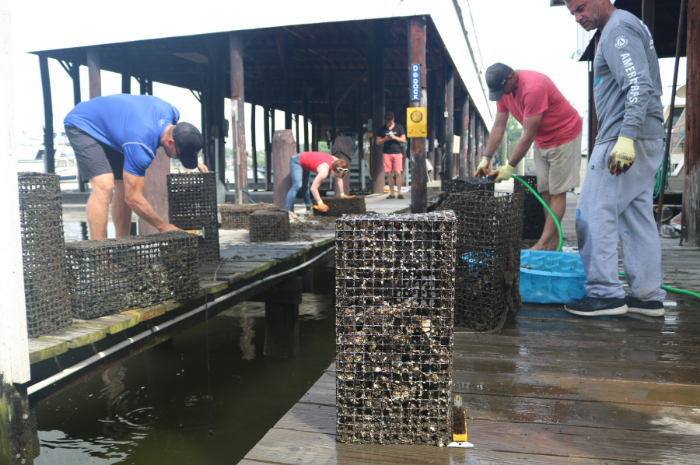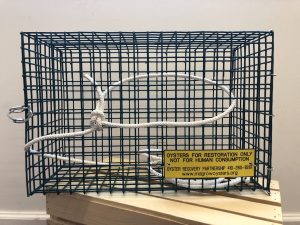
After I fill out the sign-up form, what can I expect?
Thank you for your interest in the program! We will pass along your contact info to your local tributary coordinator. This person will be your main point of contact throughout the program. They will reach out initially to get to know you and find out how many cages of spat-on-shell you’d like to maintain, i.e. hang from your dock. In the fall timeframe, they will let you know when and where your cages are ready for pickup. At the time of pickup, they will give you a short briefing and information on how to care for your oysters, and then you will receive your oysters and cages to take home.
How big are the cages?
 The cages are approximately 18″ long by 1 foot wide. After nine months, when the oysters have grown and matured, they can weigh as much as 20-30 lbs.
The cages are approximately 18″ long by 1 foot wide. After nine months, when the oysters have grown and matured, they can weigh as much as 20-30 lbs.
What do I do with the cages?
On the day you receive your cages, attach them to your pier or wharf (with the rope provided) so the cage hangs at least six inches off the bottom, away from sand and silt. IMPORTANT! The cage should not touch the bottom. Please also note that frigid winter weather – exposure to freezing air – is deadly to oysters, so your cages should be far enough below the water surface that they will not be exposed.
What type of maintenance is required for oysters and cages?
Very little maintenance! Your main upkeep duties will be to keep the cages clean and, during the winter, keep them from freezing.
For cleaning: Every two weeks, rinse your oysters by lifting the cage up and down out of the water to remove silt and sediment buildup, i.e. dunk them like a tea bag. If needed, you can rinse them with a hose if you have one at your pier or you can scrub the cages with a brush and then rinse them by dunking them in the water. You don’t need to scrub the shells or the oysters. The goal is to reduce fouling growth on the wire cage so water can flow through to the oysters and so the cage doesn’t become too heavy.
During the winter, oysters will die if exposed to freezing temperatures, so they must be kept entirely in the water, even on very low winter tides. Place the cages just above the creek bottom to minimize the potential for freezing. In the spring, you can raise the cage.
What happens at the end of the growing period?
In about nine months, your coordinator will contact you, and arrangements will be made for the oysters’ permanent placement in a sanctuary, an area closed to oyster harvesting.
What to do with cages after oysters are collected?
Immediately after your oysters are collected, please air dry your cages. If you would like to continue with the MGO program, be sure to tell your local coordinator and store your cages until the fall, when you will receive your new spat-on-shell. If you elect not to continue in the program, your cages will be collected and redistributed to other participants.
What if I have additional questions?
Please read through all the FAQs first. Still can’t find the info you need? Contact the MGO Program manager: [email protected].
